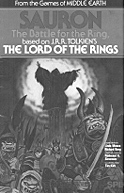
designed by Linda Mosca & Rich Berg
published by SPI, 1977
Players 2
Playing Time 2 hours
Era Tolkien fantasy
Scale operational
Time abstract
Distance abstract
Units individual leaders and groups
Components
1 22"x17" unmounted two-color map
100 diecut counters
4-page Standard Rules booklet
14-page Exclusive Rules booklet
2 identical playing aids
2 plastic dice
1 clear plastic folio container
8 1/2 x11" cover sheet
Counter Manifest
Sauron (black on red
3 Leaders (Sauron; Ringwraith; Gorgol)
17 Orcs (9*D3Y; 8*Ee3Y)
10 Slaves (A1Z)
7 Goblins (Ee2Z)
5 Wargs (D2Z)
3 Trolls (B3X)
5 Markers (Beast of Mordor; Pedestal; Game Turn; 2*Demoralized)
Westernesse/Alliance (black on blue)
6 Leaders (Elendil; Gil-galad; Isildur; Cirdan; Baldrim; Anarion)
20 Men (6*D3X; 5*B3W; 3*e1X; 2*De2Y; 2*B3X; 2*B1Y)
17 Elves (7*D4W; 5*De3X; 5*e2X
3 Dwarves (B3X)
2 Magic Weapons (Aiglos; Narsil)
2 Demoralized markers
What SPI said:
“The Game System for the Battle Games Gondor and Sauron simulates two important battles from the fictional Lord of the Rings fantasy by J.R.R. Tolkien ... Sauron is a simulation of the greatest battle of the Second Age of Middle Earth.”
What the designer said:
“The major problem in designing the Sauron game was that there was very little information on the actual battle, other than that it took place. Even The Silmarillion provides little insight on a battle level into this cataclysmic event.
Therefore most of the Order of Battle, weaponry, etc., was derived from hints and suggestions spread throughout the Ring novel. In addition to that -- and mostly for play purposes -- we added a few inventions of our own.”
What the reviewer said:
“Strictly speaking the game Sauron comes from the book The Silmarillion, and is the battle of the Seige of Mordor, where Elendil broke his blade fighting the Dark Lord” C. Wheeler in Wargamer 7.
“[T]he usual Outnumbered but Skillful Good Guys against the Stupid Hordes.” J. Witek in Web-Grognards.
“[A]dequate, but nothing more” David Ritchie in The Space Gamer 17.
Collector’s Value
Boone lists low, high and average prices of 7/15/11.33 at auction and 4/45/17.88 for sale.
Fantasy was never SPI’s forte, and this was evident in that they didn’t print as many games of their fantasy titles as they did of their standard wargames. Prices for Middle Earth and its three components (Lord of the Rings; Gondor and Sauron) have thus always been on the high end. However, I suspect that current prices are considerably higher thanks to the recent release of the movie, and will gradually come back down as Ring fever subsides.
Player’s Value
Sauron is an unusual wargame, fantasy or otherwise, in that it represents a meeting engagement. It is also one of a very few board wargames designed by a woman.
But purists will likely be unhappy at the compromises that had to be made to flesh out a very sketchy battle description and to provide some semblance of play balance. And realists will never be able to coexist with such basic fantasy concepts as magic and monsters and different races.
The system is short enough and simple enough that SPI touted the game as a potential introduction for non wargamers.
Other games by Linda Mosca
[All SPI] Gondor (1977); King Arthur: Stonehenge 536 (1979); Rocroi (1976).
Back to Simulacrum Vol. 4 No. 3 Table of Contents
Back to Simulacrum List of Issues
Back to MagWeb Master Magazine List
© Copyright 2002 by Steambubble Graphics
This article appears in MagWeb (Magazine Web) on the Internet World Wide Web. Other military history articles and gaming articles are available at http://www.magweb.com